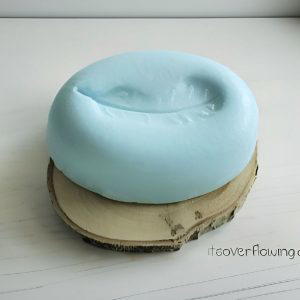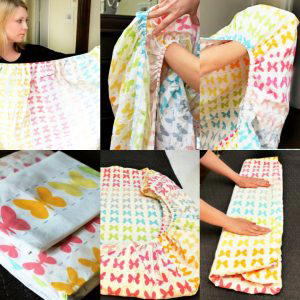Tapestries serve as versatile and essential elements of home decor, adding a touch of artistry and warmth to any space. The correct hanging of a tapestry can significantly enhance the aesthetic appeal of a room and create a cozy atmosphere that reflects your style and personality.
Whether you want to showcase a vibrant tapestry as a focal point or add a subtle accent to your walls, knowing how to hang a tapestry properly is key. There are various methods to hang a tapestry, from using nails or pushpins for a secure display to utilizing adhesive hooks for a damage-free solution.
By understanding the different techniques available, you can effortlessly elevate your living space and transform it into a personalized sanctuary that exudes charm and elegance. Stay tuned to discover the best ways to hang your tapestry and unleash the full potential of your home decor.
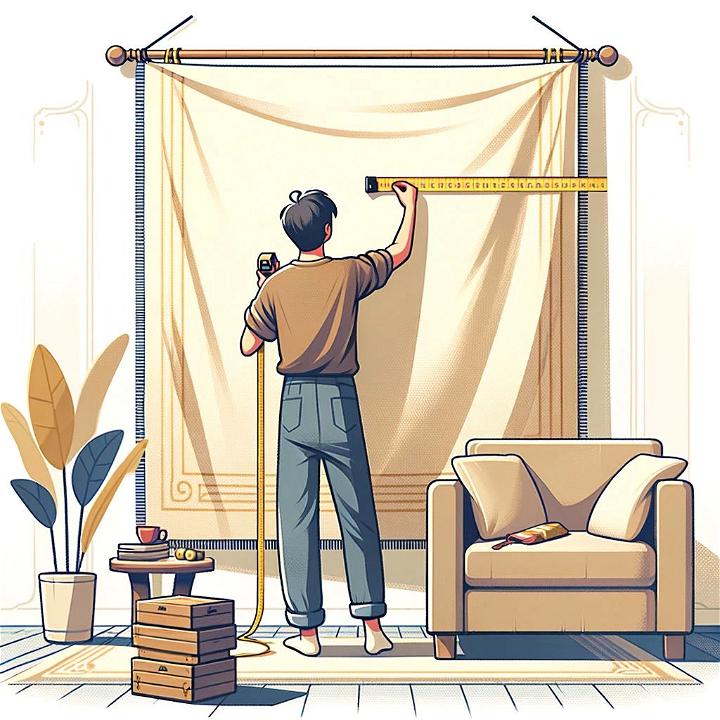
Choosing the Right Location
Deciding on the perfect spot to hang your tapestry can significantly impact the overall look and feel of your space. Consider the wall material and the room layout to ensure your tapestry is not only securely hung but also enhances the aesthetics of the room.
Consider the Wall Material
Different wall materials require specific hanging methods to ensure your tapestry stays securely in place. For drywall, lightweight tapestries can typically be hung using wall anchors or adhesive hooks. In contrast, for plaster or brick walls, you may need sturdier hanging solutions like screws or nails. It’s essential to choose the appropriate hanging method based on the wall material to prevent damage and ensure the tapestry remains in place.
Assessing the Room Layout
When determining the ideal location to hang your tapestry, take into account the overall room layout, furniture placement, and existing decor. Consider the focal points in the room and choose a wall that allows the tapestry to stand out without overwhelming the space. Ensure that the tapestry complements the existing decor and doesn’t clash with other elements in the room. By assessing the room layout and surroundings, you can create a harmonious and visually appealing display that enhances the ambiance of the space.
Methods for Hanging a Tapestry
Hanging a tapestry can transform a space, adding texture and style. Explore various ways to hang a tapestry securely and beautifully.

Using Nails or Pushpins
One of the classic ways to hang a tapestry is by using nails or pushpins. Ensure proper spacing between the nails or pins to prevent fabric strain. Start by determining the desired height and gently hammer in the nails, adjusting the alignment as needed. This method is suitable for heavier tapestries that require sturdy support. A well-hung tapestry can be a centerpiece in your room, creating a focal point that enhances the ambiance.
Adhesive Hooks and Strips
For a damage-free hanging solution, adhesive hooks and strips offer convenience, especially in rented spaces or for temporary displays. Choose high-quality adhesive hooks that can hold the weight of your tapestry. Follow the instructions for applying and removing the hooks to avoid any wall damage. This method provides a hassle-free way to showcase your tapestry without leaving marks behind.
Rod or Curtain Rod Method
Using a rod or curtain rod to hang a tapestry provides versatility and ease of change. Slide the rod through the sleeve or attachment on the tapestry and secure it in place. This method allows you to swap out tapestries quickly, giving you the freedom to refresh your decor whenever you desire. Consider using decorative rods to complement the style of your tapestry and space.
Velcro Tapestry Hanging
Velcro offers an innovative and reusable solution for hanging tapestries. Attach one side of the velcro to the wall and the other to the tapestry for a secure and flat display. Velcro tapestry hanging ensures stability and prevents the tapestry from sagging over time. This method is ideal for intricate or delicate tapestries that need a uniform display. Embrace the flexibility of velcro for effortless tapestry changes and adjustments.
Enhance your living space with these versatile tapestry hanging methods that cater to different preferences and wall types. Experiment with each technique to find the one that best suits your tapestry and decor style.
Enhancing the Display
When it comes to hanging a tapestry, enhancing its display can take your room’s decor to the next level. By strategically incorporating various elements, you can create a visually striking focal point that elevates the overall ambiance of the space.
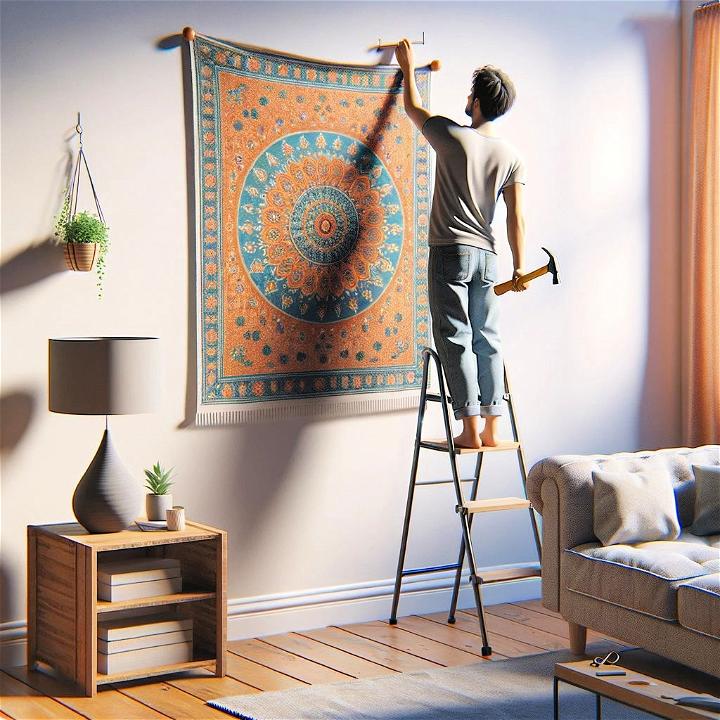
Lighting Effects
Strategic lighting plays a crucial role in accentuating the texture and colors of a tapestry. By positioning light sources strategically, you can create shadows that enhance the depth of the tapestry, making it more visually appealing. Soft, warm lighting can bring out the intricacies of the fabric and emphasize the craftsmanship behind the artwork.
Layering with Textures
To add dimension and visual interest to your tapestry display, consider layering with textures. Combining different textiles such as rugs, cushions, or throw blankets can create a cozy and inviting atmosphere. Mixing textures not only complements the tapestry but also adds a tactile element to the decor. Experiment with contrasting textures to achieve a balanced and harmonious look.
Incorporating Wall Art
Integrating wall art alongside a tapestry can create a cohesive and dynamic wall arrangement. Whether it’s hanging paintings, frames, or mirrors, combining different elements can enhance the overall aesthetic appeal of the space. Blending the tapestry with other wall decor items can create a gallery-like feel, showcasing your unique style and personality.
Enhancing the display of your tapestry through lighting effects, texture layering, and incorporating wall art can transform a simple wall hanging into a captivating focal point that reflects your personal taste and creativity. Embrace the opportunity to experiment with different elements to create a visually stunning tapestry display that complements your living space.
Maintenance and Care Tips
Taking care of your tapestry is essential to preserve its beauty and longevity. Proper maintenance routines can significantly extend the lifespan of your tapestry, ensuring it remains a captivating centerpiece in your living space. Let’s explore some key maintenance and care tips for your treasured tapestries.
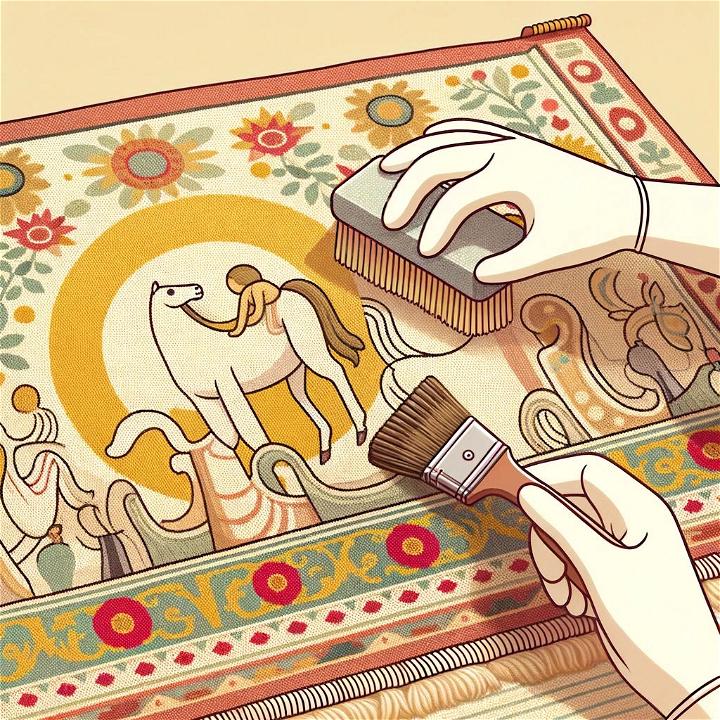
Regular Dusting and Vacuuming
One of the most fundamental maintenance practices for tapestries is regular dusting and gentle vacuuming. Dust accumulation not only dulls the colors of your tapestry but can also lead to the deterioration of the fibers, especially in high-traffic areas. To prevent this, use a soft-bristle brush or a vacuum cleaner with an upholstery attachment to gently remove dust from the surface. This simple routine will help keep your tapestry looking fresh and vibrant for years to come.
Spot Cleaning Techniques
Accidents happen, and knowing how to address stains or spills promptly can make a significant difference in preserving your tapestry. For spot cleaning, opt for mild detergents diluted in water and a soft cloth. Avoid harsh chemicals that can damage the fibers. When blotting the stain, remember to work from the outer edges towards the center to prevent spreading. Carefully following these spot cleaning techniques can help maintain the pristine condition of your tapestry.
Proper Storage Practices
When your tapestry is not on display, proper storage is crucial to prevent damage and ensure its longevity. Store your tapestry in a cool, dry place away from direct sunlight to avoid color fading. Opt for a breathable covering to protect it from dust while allowing airflow. Additionally, beware of moisture and pests, as they can cause irreparable harm to your tapestry. By following these storage practices, you can safeguard the beauty and quality of your tapestry for generations to come.
Remember, a little care and attention go a long way in preserving the beauty of your tapestry. Incorporating these maintenance tips into your routine will not only enhance the visual appeal of your tapestry but also protect it for years of enjoyment.
FAQs
Have questions about hanging a tapestry? Here are some common FAQs answered to help you with your tapestry hanging project.
1. How Do I Hang a Tapestry Without Damaging the Wall?
One popular method to hang a tapestry without damaging the wall is by using 3M Command Strips. These strips allow you to attach the tapestry to the wall without leaving any marks or residue when removed. Simply follow the instructions on the packaging for a damage-free hanging solution.
2. What Tools Do I Need to Hang a Tapestry?
To hang a tapestry, you might need tools such as nails, pushpins, hooks, or curtain rods depending on the weight and size of the tapestry. It’s essential to choose the appropriate tools that can securely hold the tapestry without causing any damage to the wall.
3. Can I Hang a Tapestry on a Ceiling?
Yes, you can hang a tapestry on a ceiling to add a unique and artistic touch to your space. Consider using ceiling hooks or adhesive hooks designed for ceilings to securely hang the tapestry. Make sure to check the weight capacity of the hooks to ensure they can support the tapestry.
4. How Do I Ensure My Tapestry Hangs Straight?
Achieving a straight and even hang for your tapestry can be done by using a level tool while positioning and adjusting the tapestry on the wall. Start by marking the desired height and level line for the tapestry before hanging it to maintain a balanced and straight display.
Remember, the key to successfully hanging a tapestry lies in choosing the right method and tools that suit your tapestry’s size and weight, ensuring a secure and visually pleasing display.
Conclusion
Properly hanging a tapestry can significantly enhance the décor of your home by adding a touch of creativity and personalization. Experimenting with different hanging methods allows you to create unique displays that reflect your style and preferences. Whether you opt for adhesive hooks, nails, or innovative techniques, the key is to ensure your tapestry is secure and well-displayed. So, don’t hold back – get creative and transform your living space with a beautifully hung tapestry!
Related Projects
- Discover the art of making a DIY tapestry and show your creativity with step-by-step instructions, tips, and inspiration.











